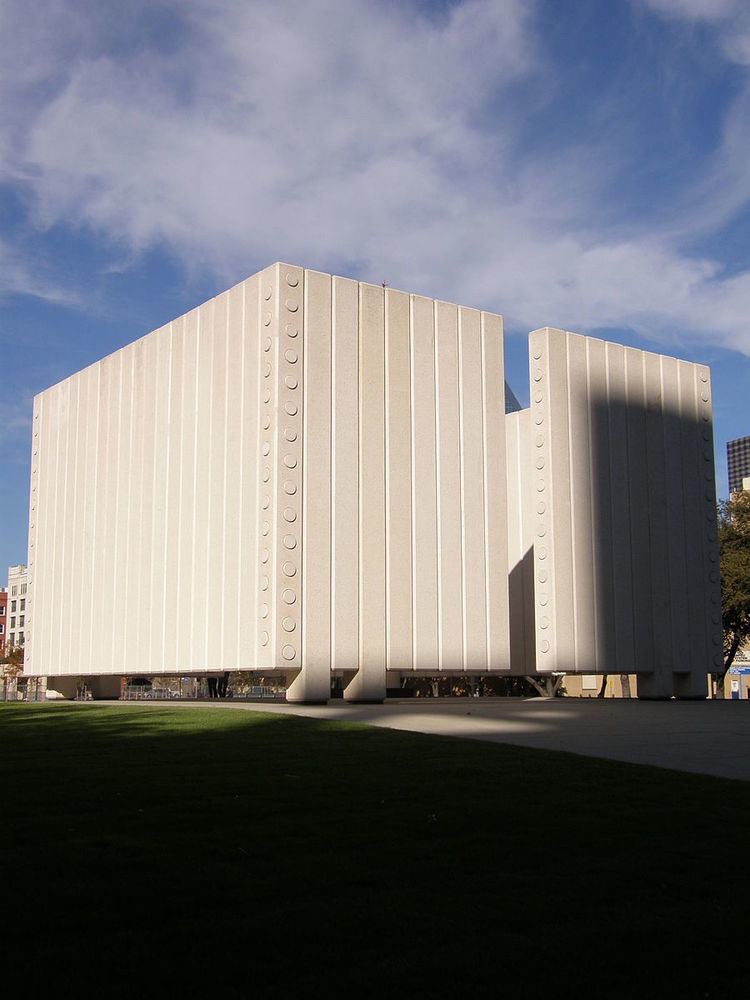Phone +1 214-747-6660 | ||
 | ||
Address 646 Main St, Dallas, TX 75202, USA Hours Open today · 10AM–6PMSunday10AM–6PMMonday12–6PMTuesday10AM–6PMWednesday10AM–6PMThursday10AM–6PMFriday10AM–6PMSaturday10AM–6PM Similar Sixth Floor Museum at Dealey Pl, Dealey Plaza, Dallas World Aquarium, Dallas County Courthouse, Pioneer Plaza | ||
The John Fitzgerald Kennedy Memorial is a monument to U.S. President John Fitzgerald Kennedy in the West End Historic District of downtown Dallas, Texas (USA) erected in 1970, and designed by noted architect Philip Johnson.
Contents
Description
The JFK Memorial was the first memorial by famed American architect and Kennedy family friend, Philip Johnson. The monument was approved by Jacqueline Kennedy herself. Johnson called it "a place of quiet refuge, an enclosed place of thought and contemplation separated from the city around, but near the sky and earth." The citizens of Dallas funded its construction entirely.
The simple, concrete memorial to President Kennedy dominates a square in downtown Dallas owned by Dallas County, and bordered by Main, Record, Elm and Market Streets, one block east of Dealey Plaza, where Kennedy was assassinated.
Philip Johnson's design is a cenotaph, or empty tomb, that symbolizes the freedom of Kennedy’s spirit. The memorial is a square, roofless room, 30 feet (9 m) high and 50 (15 m) by 50 feet (15 m) wide with two narrow openings facing north and south. The walls consist of 72 white precast concrete columns, most of which seem to float with no visible support two feet above the earth. Eight columns extend to the ground, acting as legs that seem to hold up the monument. Each column ends in a light fixture. At night, the lights create the illusion that the structure is supported by the light itself. The corners and “doors” of this roofless room are decorated with rows of concrete circles, or medallions, each identical and perfectly aligned. These decorations introduce the circular shape into the square architecture of the Kennedy Memorial.
Visitors enter the room after a short walk up a slight concrete incline, embossed with concrete squares. Inside visitors confront a low-hewn granite square, too empty to be a base, too short to be a table, but too square to be a tomb, in which the name John Fitzgerald Kennedy is carved. The letters have been painted gold to capture the light from the white floating column walls and the pale concrete floor. These words – three words of a famous name – are the only verbal messages in the empty room.
A square granite memorial next to this marker reads:
The joy and excitement of John Fitzgerald Kennedy’s life belonged to all men. So did the pain and sorrow of his death. When he died on November 22, 1963, shock and agony touched human conscience throughout the world. In Dallas, Texas, there was a special sorrow. The young President died in Dallas. The death bullets were fired 200 yards west of this site. This memorial, designed by Philip Johnson, was erected by the people of Dallas. Thousands of citizens contributed support, money and effort. It is not a memorial to the pain and sorrow of death, but stands as a permanent tribute to the joy and excitement of one man’s life. John Fitzgerald Kennedy’s life.
Management
In mid 1999, The Sixth Floor Museum at Dealey Plaza undertook management of the memorial, rallying the support of Dallas County and the City of Dallas. The Museum became caretaker of the monument and launched a full-scale restoration project aimed at preserving the memorial and its history. Philip Johnson, the original architect for the monument, guided the restoration process implemented by Corgan Associates, Inc. and Phoenix I Restoration and Construction, Lt. Numerous local suppliers donated the labor, materials, and equipment required to return the memorial to its original beauty. In 2000, a panel of experts wrote an explanation of the memorial to satisfy the public.
Critical reception
Architectural critic Witold Rybczynski wrote that the monument is "poorly done", likening its precast concrete slab walls to "mammoth Lego blocks", and commented that Kennedy "deserved better".
